This page briefly covers most of the Fiat cars from the inter-war period, named using a series of numbers in the range 501 to 527. They are presented in numerical (not chronological) order.
[501] [502] [503] [505] [507] [508] [509] [510] [512] [514] [515] [518] [519] [520 Super Fiat] [520] [521] [522] [524] [525] [527]
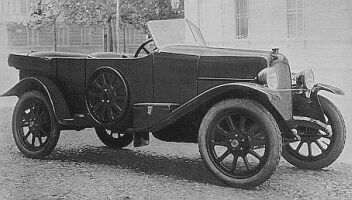 Built
from 1919 until 1926, this was the first new Fiat after the First world
war. The smallest model in the range when it was launched, it was built
with many different body styles and in various versions. The total number
built was around 45,000.
Built
from 1919 until 1926, this was the first new Fiat after the First world
war. The smallest model in the range when it was launched, it was built
with many different body styles and in various versions. The total number
built was around 45,000.
In 1921 the 501S (available with three
bodies : Torpedo sportiva, Spider and Spider sportiva) and SS (available
solely with the Spider sportiva body) models were added to the line-up.
As well as the different body styles, these models featured more powerful
engines. Around 2,600 'Sport' models were built.
A competition version, the 802, was also
built. This used a twin-cam 1486cc engine with 55bhp @ 4500rpm and included
in its many successes the 1922 Targa Florio. This model featured brakes
on all wheels as standard.
1923 saw the 501C or Coloniale model released.
This was lightened, had a wider track and was built with Torpedo, Torpedo
lusso, Berlina and Spider bodies.
Technical Details
| Engine | 1460cc (65x110mm) sidelvalve in-line four cylinder with 23bhp @ 2,600rpm
'S' with 26.5bhp, 'SS' with 30bhp |
| Suspension | front : rigid axle with leaf springs
rear : rigid axle with leaf springs wheelbase : 2650mm track (front/rear) : 1250mm/1250mm (Coloniale : 1400mm front & rear) |
| Brakes | drums at rear (the last cars also had drums at the front) |
| Gearbox | 4 speed manual |
| Empty weight | 501 berlina : 1000kg
501 Coloniale (berlina) : 900kg |
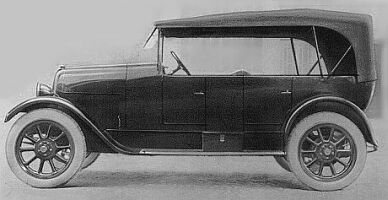 The
502, built from 1923 until 1926, was effectively a slightly stretched,
and thus more upmarket, version of the 501. The engine and main mechanical
parts remained the same, whilst the wheelbase increased by 100mm. Torpedo
and Coupé de Ville versions were built. As with the 501, brakes
were also fitted at the front on later models. Around 20,000 cars were
built.
The
502, built from 1923 until 1926, was effectively a slightly stretched,
and thus more upmarket, version of the 501. The engine and main mechanical
parts remained the same, whilst the wheelbase increased by 100mm. Torpedo
and Coupé de Ville versions were built. As with the 501, brakes
were also fitted at the front on later models. Around 20,000 cars were
built.
Technical Details
| Engine | 1460cc (65x110mm) sidelvalve in-line four cylinder with 23bhp @ 2,600rpm |
| Suspension | front : rigid axle with leaf springs
rear : rigid axle with leaf springs wheelbase : 2750mm track (front/rear) : 1400mm/1400mm |
| Brakes | drums at rear (the last cars also had drums at the front) |
| Gearbox | 4 speed manual |
| Empty weight | Torpedo : 1020kg |
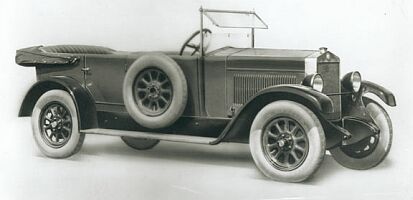 The
503 was a slightly more powerful version of the 501/502 pair, using the
longer wheelbase of the latter. Various other small modifications were
also made including the suspension and brakes. Entering production in 1926
and finishing production in the following year, around 42,000 were built
with a variety of bodystyles.
The
503 was a slightly more powerful version of the 501/502 pair, using the
longer wheelbase of the latter. Various other small modifications were
also made including the suspension and brakes. Entering production in 1926
and finishing production in the following year, around 42,000 were built
with a variety of bodystyles.
Technical Details
| Engine | 1460cc (65x110mm) sidelvalve in-line four cylinder with 27bhp @ 3,000rpm |
| Suspension | front : rigid axle with leaf springs and friction dampers
rear : rigid axle with leaf springs and friction dampers wheelbase : 2750mm track (front/rear) : 1400mm/1400mm |
| Brakes | drums all round |
| Gearbox | 4 speed manual |
| Empty weight | Berlina : 1100kg |
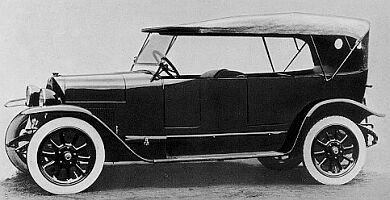 Released
in the same year as the smaller 501, the 505 was a larger car with a larger
engine. Again built with various bodystyles, mechanically it followed the
same layout as the 501, including the adoption of front brakes late in
its life. The second series received a square radiator in place of the
earlier rounded unit, with a correspondingly more angular bonnet. Around
30,000 cars were built until 1925.
Released
in the same year as the smaller 501, the 505 was a larger car with a larger
engine. Again built with various bodystyles, mechanically it followed the
same layout as the 501, including the adoption of front brakes late in
its life. The second series received a square radiator in place of the
earlier rounded unit, with a correspondingly more angular bonnet. Around
30,000 cars were built until 1925.
Technical Details
| Engine | 2296cc (75x130mm) sidelvalve in-line four cylinder with 30bhp @ 2,300rpm |
| Suspension | front : rigid axle with leaf springs
rear : rigid axle with leaf springs wheelbase : 3050mm track (front/rear) : 1410mm/1410mm |
| Brakes | drums at rear (the last cars also had drums at the front) |
| Gearbox | 4 speed manual |
| Empty weight | Torpedo : 1540kg |
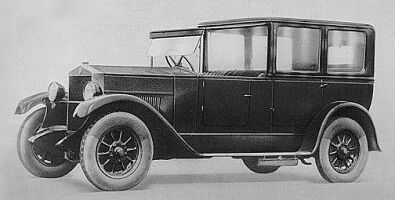 The
replacement for the 505, the 507 was really a heavily modified and improved
version of that earlier car. The engine gained some power, the suspension
gained friction dampers, and the front wheels gained brakes. Built for
only two years, some 3,701 exapmles were produced.
The
replacement for the 505, the 507 was really a heavily modified and improved
version of that earlier car. The engine gained some power, the suspension
gained friction dampers, and the front wheels gained brakes. Built for
only two years, some 3,701 exapmles were produced.
Technical Details
| Engine | 2296cc (75x130mm) sidelvalve in-line four cylinder with 35bhp @ 2,600rpm |
| Suspension | front : rigid axle with leaf springs and friction dampers
rear : rigid axle with leaf springs and friction dampers wheelbase : 3050mm track (front/rear) : 1410mm/1410mm |
| Brakes | drums all round |
| Gearbox | 4 speed manual |
| Empty weight | Torpedo : 1450kg |
See the separate 508 / Balilla / 1100 page.
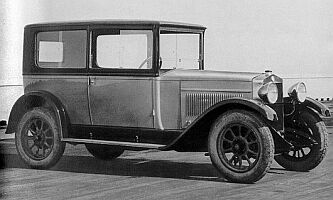 The
first real 'compact' car with a sub-1-litre engine produced in volume by
Fiat, the 509 was first shown at the Paris show in 1924 (chassis only)
and then the complete car in 1925 at the Milan show. Numerous bodystyles,
Berlina, Torpedo, Cabriolet, Spider, Coupe and Coupe Royal were built.
Noteable features were the overhead valves and overhead camshafts. In 1928
509 Berlinas took the first two places in the Montecarlo Rally. In 1926
the second series, or 509A, was introduced, with various small improvements
such as the carburettor and tyres. New bodies which became available with
that model were the Sportive, Taxi and Commerciale. The latter had a removeable
rear door and seats to leave a flat load area.
The
first real 'compact' car with a sub-1-litre engine produced in volume by
Fiat, the 509 was first shown at the Paris show in 1924 (chassis only)
and then the complete car in 1925 at the Milan show. Numerous bodystyles,
Berlina, Torpedo, Cabriolet, Spider, Coupe and Coupe Royal were built.
Noteable features were the overhead valves and overhead camshafts. In 1928
509 Berlinas took the first two places in the Montecarlo Rally. In 1926
the second series, or 509A, was introduced, with various small improvements
such as the carburettor and tyres. New bodies which became available with
that model were the Sportive, Taxi and Commerciale. The latter had a removeable
rear door and seats to leave a flat load area.
The performance versions were also introduced
in 1925, the 509S ('Spinto') and the 509SM ('Spinto Monza') available as
normal and 'Coppa Florio' versions. The engines were tuned depending upon
the model, and in 1926 a small number of supercharger versions, known as
the 509SC, were also built. The 509S was generally fitted with a two-seat
Bateau body (mostly wooden), whilst the 509SM had a competition type bodywork.
These cars were widely used in motorsport, with many successes.
Over 90,000 examples of the 509 were built.
Technical Details
| Engine | 990cc (57x97mm) sohc in-line four cylinder with 22bhp @ 3,400rpm
509S : 27bhp 509SM : 30bhp 509SM Coppa Florio : 35bhp |
| Suspension | front : rigid axle with leaf springs (friction dampers on 'S' models)
rear : rigid axle with leaf springs (friction dampers on 'S' models) wheelbase : 2550mm track (front/rear) : 1200mm/1200mm |
| Brakes | drums all round |
| Gearbox | 3 speed manual |
| Empty weight | Berlina : 795kg
509S : 665kg |
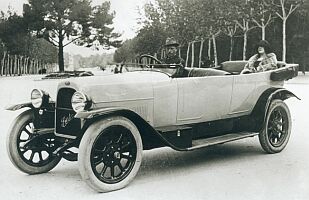 The
next model up from the 505, the 510 followed the mechanical layout of its
smaller bretheren, but now with a 3.5-litre six cylinder engine. Four body
styles were built, Berlina, Torpedo, Coupé de Ville and Landaulet
Torpedo. As with the 505 the second series was fitted with a square radiator,
whilst later there arrived the 510B with brakes also on the front wheels.
Around 13,500 cars were built until 1925.
The
next model up from the 505, the 510 followed the mechanical layout of its
smaller bretheren, but now with a 3.5-litre six cylinder engine. Four body
styles were built, Berlina, Torpedo, Coupé de Ville and Landaulet
Torpedo. As with the 505 the second series was fitted with a square radiator,
whilst later there arrived the 510B with brakes also on the front wheels.
Around 13,500 cars were built until 1925.
From 1920 there was also produced the
510S or Sport. Produced only as a Torpedo, this had a shorter wheelbase,
V-shaped radiator grille and windscreen, no running boards and a slightly
more powerful engine. Front brakes were also standard. Over 400 examples
were built.
Technical Details
| Engine | 3446cc (75x130mm) sidelvalve in-line six cylinder with 46bhp @ 2,400rpm
510S : 53bhp @ 2,500rpm |
| Suspension | front : rigid axle with leaf springs
rear : rigid axle with leaf springs wheelbase : 3400mm (510S : 3100mm) track (front/rear) : 1410mm/1410mm |
| Brakes | drums at rear (510AS & 510B also with drums at the front) |
| Gearbox | 4 speed manual |
| Empty weight | Torpedo : 1570kg
510S : 1535kg |
Replacing the 510 in 1926, the 512 was a mildly revised and updated version of the latter model. The main changes were the addition of front brakes and friction dampers. The wheelbase, engine and dimensions remained unchanged. Bodystyles included Limousine, Coupé de Ville and Torpedo versions. It continued in production until 1928, by which time 2,583 examples had been built, many of which were exported.
Technical Details
| Engine | 3446cc (75x130mm) sidelvalve in-line six cylinder with 46bhp @ 2,400rpm |
| Suspension | front : rigid axle with leaf springs and friction dampers
rear : rigid axle with leaf springs and friction dampers wheelbase : 3400mm track (front/rear) : 1410mm/1410mm |
| Brakes | drums all round |
| Gearbox | 4 speed manual |
| Empty weight | Limousine : 1760kg |
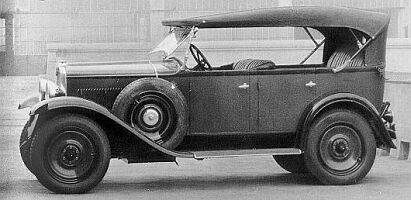 The
514 was introduced in 1929 to replace the 509. Using a new 1.4-litre engine
on a similar wheelbase, the 514 was built until 1932, by which time a total
of 36,970 examples of all types had been built. During its production life
the 514 saw the introduction of hydraulic dampers to replace the original
friction units as well as other small improvements. Bodystyles included
Berlina, Coupe, Cabriolet Royal, Torpedo and Spider as well as a longer
wheelbase variant, the 514L, designed to be used as a taxi and also fitted
with a van body.
The
514 was introduced in 1929 to replace the 509. Using a new 1.4-litre engine
on a similar wheelbase, the 514 was built until 1932, by which time a total
of 36,970 examples of all types had been built. During its production life
the 514 saw the introduction of hydraulic dampers to replace the original
friction units as well as other small improvements. Bodystyles included
Berlina, Coupe, Cabriolet Royal, Torpedo and Spider as well as a longer
wheelbase variant, the 514L, designed to be used as a taxi and also fitted
with a van body.
Three sport versions were built. The 514S
used a slightly tuned engine in the standard chassis, whilst the 514MM
(Mille Miglia) used a more highly tuned engine in a longer chassis and
the 514CA (Coppa delle Alpi) used the more highly tuned engine in the shorter
(standard) chassis.
Technical Details
| Engine | 1438cc (67x102mm) sidevalve in-line four cylinder with 28bhp @ 3,400rpm
509S : 34.5bhp @ 3,500rpm 509MM & CA : 37bhp @ 3,700rpm |
| Suspension | front : rigid axle with leaf springs and friction dampers, later hydraulic units
rear : rigid axle with leaf springs and friction dampers, later hydraulic units wheelbase : 2555mm (514L & MM : 2770mm) track (front/rear) : 1214mm/1220mm (514S : 1214mm/1238mm)(514CA : 1220mm/1246mm) |
| Brakes | drums all round, later cars used a hydraulic system |
| Gearbox | 4 speed manual |
| Empty weight | 514 Berlina 2-door : 1005kg
514 S : 875kg 514 CA : 985kg |
A hybrid model produced by fitting the 1.4-litre engine of the 514 into the larger chassis of the six-cylinder 522, the result was a large but economic vehicle, produced as a four door berlina. A longer wheelbase version, the 515T or Taxi, was also built, either as a Berlina-Landaulet (with two or four windows) or a Landaulet (with two or three windows). Built until 1935 a total of 3,405 examples were produced.
Technical Details
| Engine | 1438cc (67x102mm) sidevalve in-line four cylinder with 28bhp @ 3,400rpm |
| Suspension | front : rigid axle with leaf springs and hydraulic dampers
rear : rigid axle with leaf springs and hydraulic dampers wheelbase : 2580mm (Taxi : 2870mm) track (front/rear) : 1410mm/1450mm |
| Brakes | drums all round with hydraulic system |
| Gearbox | 4 speed manual |
| Empty weight | 1145kg (Taxi : 1700kg) |
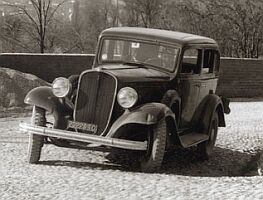 More
commonly known as the 'Ardita', the 518 was the bigger brother of the 508
Balilla. The engine was either a 1750 or a 2-litre four (hence the Ardita
1750 and the Ardita 2000), still with sidevalves, whilst the style followed
that of its smaller relative.
More
commonly known as the 'Ardita', the 518 was the bigger brother of the 508
Balilla. The engine was either a 1750 or a 2-litre four (hence the Ardita
1750 and the Ardita 2000), still with sidevalves, whilst the style followed
that of its smaller relative.
Two wheelbases were again produced, the
518C and the 518L, both available with either engine. A Sport version,
the 518S, was only available on the shorter wheelbase with a 2-litre engine,
mildly tuned, and a closed, four-seat. 'sport' bodywork. The 518 Coloniale
was built on both wheelbases with a reduced performance but a more robust
construction.
Technical Details
| Engine | 1758cc (78x92mm) sidevalve in-line four cylinder with 40bhp @ 3,600rpm
1944cc (82x92mm) sidevalve in-line four cylinder with 45bhp @ 3,600rpm |
| Suspension | front : rigid axle with leaf springs and hydraulic dampers
rear : rigid axle with leaf springs and hydraulic dampers wheelbase : 518C : 2700mm; 518L : 3000mm track (front/rear) : 1390mm/1410mm |
| Brakes | drums all round with hydraulic system |
| Gearbox | 4 speed manual, 3rd & 4th gear synchronised |
| Empty weight | 518C (both) : 1185kg
518L (1750) : 1259kg 518L (2000) : 1275kg |
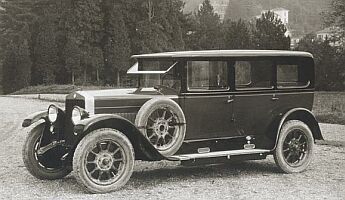 Effectively
the top of the Fiat range (given the almost insignificant number of 'Super
Fiat's produced), the 519 used a larger six cylinder engine and longer
chassis than the older 510. Born in 1922, the first series, or 519A, was
replaced in 1925 by the improved second series, or 519B. The major difference
regarded the improved rear suspension. A third version, the 519C or Coloniale
was also produced, which had a stronger suspension and increased ground
clearance. Production continued until 1927.
Effectively
the top of the Fiat range (given the almost insignificant number of 'Super
Fiat's produced), the 519 used a larger six cylinder engine and longer
chassis than the older 510. Born in 1922, the first series, or 519A, was
replaced in 1925 by the improved second series, or 519B. The major difference
regarded the improved rear suspension. A third version, the 519C or Coloniale
was also produced, which had a stronger suspension and increased ground
clearance. Production continued until 1927.
Standard features, emphasising the class
of the vehicle, included overhead valves (up until then almost exclusively
used in race cars) and hydraulic assisted brakes (on all four wheels).
A variety of bodystyles were produced.
The 519S or Sport featured the same engine
but used a shorter chassis and was noticeably lighter, thus having an improved
performance. A V-shaped radiator grille was also fitted, the track was
increased and the running boards were omitted. Both Torpedo and closed
versions were built. It was built from 1922 until 1924.
In total, around 2,400 examples of the
519 were constructed.
Technical Details
| Engine | 4766cc (85x140mm) overheadvalve in-line six cylinder with 77bhp @ 2,600rpm |
| Suspension | front : rigid axle with leaf springs and friction dampers
rear : rigid axle with leaf springs and friction dampers wheelbase : 3600mm (519S : 3300mm) track (front/rear) : 1460mm/1460mm (519S : 1475mm front & rear) |
| Brakes | drums all round |
| Gearbox | 4 speed manual |
| Empty weight | 519 Torpedo : 2035kg
519S Torpedo : 2000kg |
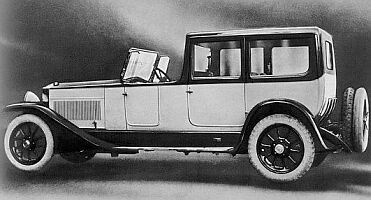 An
attempt by Fiat to enter into the more luxurious end of the car market,
the 520 or 'Super Fiat' was the first (and the last) car with that badge
to use a V12 engine. Other production-Fiat firsts were coil and distributor
ignition, overhead valves and the red circular Fiat badge first seen on
the 801 Corsa racecar. Only a couple of cars were built, almost certainly
less than five, with Torpedo and Dorsay-Torpedo bodies.
An
attempt by Fiat to enter into the more luxurious end of the car market,
the 520 or 'Super Fiat' was the first (and the last) car with that badge
to use a V12 engine. Other production-Fiat firsts were coil and distributor
ignition, overhead valves and the red circular Fiat badge first seen on
the 801 Corsa racecar. Only a couple of cars were built, almost certainly
less than five, with Torpedo and Dorsay-Torpedo bodies.
Technical Details
| Engine | 6805cc (85x100mm) overheadvalve V12 with 90bhp @ 2,000rpm |
| Suspension | front : rigid axle with leaf springs
rear : rigid axle with leaf springs wheelbase : 3860mm track (front/rear) : 1500mm/1500mm |
| Brakes | drums all round |
| Gearbox | 3 speed manual |
| Empty weight | Torpedo : 1850kg |
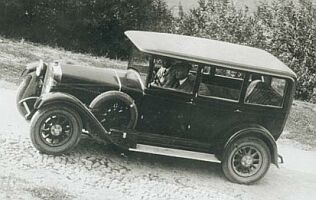 The
520 name was resurrected for this new model in 1927, after having been
used earlier for the 'Super Fiat'. The new 520 was a medium size car with
a 2.2-litre straight six engine. It was well received and over 20,000 were
built before production ceased in 1929.
The
520 name was resurrected for this new model in 1927, after having been
used earlier for the 'Super Fiat'. The new 520 was a medium size car with
a 2.2-litre straight six engine. It was well received and over 20,000 were
built before production ceased in 1929.
In 1928 the 520T or Taxi was introduced.
Designed to replace the 501 Taxi, the chassis remained the same as the
520 whilst the engine, although still a six, had its capacity reduced to
1.9-litres. The bodywork was specially designed for the role, being a Landaulet
with a rear opening canvas roof. Four seats were provided for passengers,
two being rearward facing on the partition. Around 600 of these vehicles
were built up until 1930.
Technical Details
| Engine | 2244cc (68x103mm) sidevalve in-line six cylinder with 46bhp @ 3,400rpm
Taxi : 1866cc (62x103mm) with 35bhp @ 3,300rpm |
| Suspension | front : rigid axle with leaf springs and friction dampers
rear : rigid axle with leaf springs and friction dampers wheelbase : 2900mm track (front/rear) : 1400mm/1400mm |
| Brakes | drums all round |
| Gearbox | 4 speed manual |
| Empty weight | Berlina : 1280kg
Taxi : 1250kg |
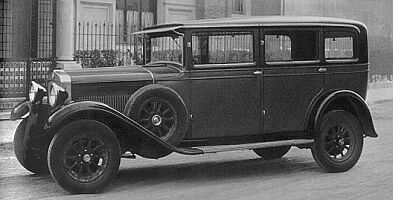 An
evolution of the 520 which it was designed to replace, the 521 had both
its engine capacity and its wheelbase increased over its predecessor. A
short wheelbase version, the 520C or Corto, was also produced which retained
the original 520 wheelbase. Being produced also at Heilbronn in Germany,
it was the first Fiat mass-produced outside of Italy. Various bodystyles
including Berlina, Limousine, Torpedo and Coupe were produced. Around 20,000
examples in total were built until 1931.
An
evolution of the 520 which it was designed to replace, the 521 had both
its engine capacity and its wheelbase increased over its predecessor. A
short wheelbase version, the 520C or Corto, was also produced which retained
the original 520 wheelbase. Being produced also at Heilbronn in Germany,
it was the first Fiat mass-produced outside of Italy. Various bodystyles
including Berlina, Limousine, Torpedo and Coupe were produced. Around 20,000
examples in total were built until 1931.
Technical Details
| Engine | 2516cc (72x103mm) sidevalve in-line six cylinder with 50bhp @ 3,400rpm |
| Suspension | front : rigid axle with leaf springs and hydraulic dampers
rear : rigid axle with leaf springs and hydraulic dampers wheelbase : 3140mm (521C : 2900mm) track (front/rear) : 1400mm/1400mm |
| Brakes | drums all round |
| Gearbox | 4 speed manual |
| Empty weight | 521 Berlina : 1460kg
521C Berlina : 1350kg |
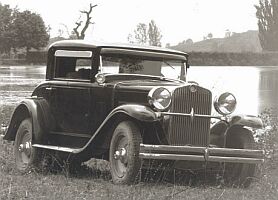 Replacing
the 521 in 1931, the 522 used a development of the former cars engine together
with a new chassis, available in two lengths, the 522C or Corto and the
522L or Lungo. Both cars had a new feature in that third and fourth gears
were synchronised whilst the coil and distributor ignition, hydraulic brakes
all round and hydraulic dampers were all already becoming the norm. A slightly
more powerful version, the 522CSS was also built, with a higher compression
ratio and twin carburettors.
Replacing
the 521 in 1931, the 522 used a development of the former cars engine together
with a new chassis, available in two lengths, the 522C or Corto and the
522L or Lungo. Both cars had a new feature in that third and fourth gears
were synchronised whilst the coil and distributor ignition, hydraulic brakes
all round and hydraulic dampers were all already becoming the norm. A slightly
more powerful version, the 522CSS was also built, with a higher compression
ratio and twin carburettors.
At the Geneva Motorshow of 1932 Fiat introduced
the 522S. Using a wheelbase between the C and L versions it had a more
powerful version of the standard engine whilst the damping reverted to
the friction type. It was built as a two or four door berlina, and 722
were completed.
The 522 remained in production until 1933,
by which time a total of over 6,000 examples had been built.
Technical Details
| Engine | 2516cc (72x103mm) sidevalve in-line six cylinder with 52bhp @ 3,300rpm |
| Suspension | front : rigid axle with leaf springs and hydraulic dampers
rear : rigid axle with leaf springs and hydraulic dampers wheelbase : 522C : 2775mm; 522L : 3070mm; 522S : 2,800mm track (front/rear) : 1410mm/1450mm |
| Brakes | drums all round with hydraulic system |
| Gearbox | 4 speed manual, 3rd & 4th gear synchronised |
| Empty weight | 522C : 1295kg
522S : 1390kg |
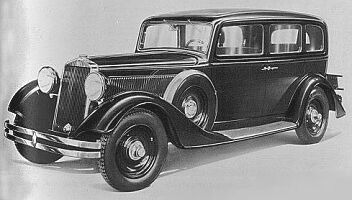 One
step up from the 522, the 524 used the same engine again with two wheelbases,
the 524C with the same wheelbase as the 522L and the 524L with a yet longer
chassis. It entered production on 1931 and was discontinued in 1934. All
the 2,275 examples built had closed bodywork and were the first Fiats to
use the new rectangular badge.
One
step up from the 522, the 524 used the same engine again with two wheelbases,
the 524C with the same wheelbase as the 522L and the 524L with a yet longer
chassis. It entered production on 1931 and was discontinued in 1934. All
the 2,275 examples built had closed bodywork and were the first Fiats to
use the new rectangular badge.
Technical Details
| Engine | 2516cc (72x103mm) sidevalve in-line six cylinder with 52bhp @ 3,300rpm |
| Suspension | front : rigid axle with leaf springs and hydraulic dampers
rear : rigid axle with leaf springs and hydraulic dampers wheelbase : 524C : 3070mm; 524L : 3230mm track (front/rear) : 524C : 1400mm/1450mm 524L : 1438mm/1460mm |
| Brakes | drums all round with hydraulic system |
| Gearbox | 4 speed manual, 3rd & 4th gear synchronised |
| Empty weight | 524C : 1400kg
524L : 1592kg |
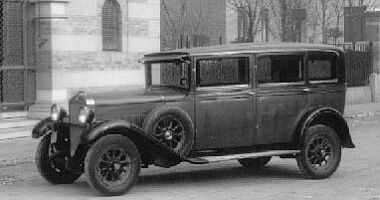 Cancelling
plans for a large, eight cylinder car (the 530) due to the prevailing economic
conditions, Fiat replaced the 512 in 1928 with the new 525. This car used
a new 3.7-litre straight-six engine and a variety of bodystyles befitting
such a model, including one built specially for the Pope in 1929. The first
cars still had friction dampers, these were replaced on later cars by hydraulic
units. Production ceased the year after it began, with only 511 examples
built.
Cancelling
plans for a large, eight cylinder car (the 530) due to the prevailing economic
conditions, Fiat replaced the 512 in 1928 with the new 525. This car used
a new 3.7-litre straight-six engine and a variety of bodystyles befitting
such a model, including one built specially for the Pope in 1929. The first
cars still had friction dampers, these were replaced on later cars by hydraulic
units. Production ceased the year after it began, with only 511 examples
built.
1929 saw three new models introduced,
the 525N, 525S and 525SS. The 525N was an improved first series car,
with a slightly shorter wheelbase, many changes to the mechanicals and
built as Berlina, Berlina Landau, Coupe, Torpedo and Spider versions. A
total of 1,784 examples were built until 1931.
The Sport versions, the 'S' and 'SS' both
had a further reduced wheelbase whilst the latter also had a more powerful
engine. The 'S' was available as Berlina, Coupe and Spider, whilst the
'SS' was a four seat spider. A total of 2,100 Sport versions were built,
construction also continuing until 1931.
Technical Details
| Engine | 3739cc (82x118mm) sidelvalve in-line six cylinder with 68.5bhp @ 3,200rpm
525SS : 88.5bhp @ 3,350rpm |
| Suspension | front : rigid axle with leaf springs and friction dampers (later hydraulic)
rear : rigid axle with leaf springs and friction dampers (later hydraulic) wheelbase : 3400mm (525N : 3260mm)(525S & SS : 3000mm) track (front/rear) : 1460mm/1460mm (525N, S & SS : 1400mm front & rear) |
| Brakes | drums all round - later versions had hydraulic braking. |
| Gearbox | 4 speed manual |
| Empty weight | 525 Berlina : 1875kg
525N Berlina : 1680kg 525S Berlina : 1560kg 525SS : 1450kg |
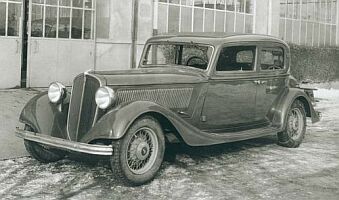 A
further development of the 518, the 527 was known as the Ardita 2500 thanks
to its 2.5-litre six cylinder engine, the same unit as in the 524. The
wheelbase was slightly longer than the 518L. Only a single variant was
produced, the 527S or SPort. With a higher compression ratio the engine
gained 8bhp, whilst the body was a four seat berlina. Starting in 1934
a total of around 1,000 examples of the 527 were built until production
stopped in 1936.
A
further development of the 518, the 527 was known as the Ardita 2500 thanks
to its 2.5-litre six cylinder engine, the same unit as in the 524. The
wheelbase was slightly longer than the 518L. Only a single variant was
produced, the 527S or SPort. With a higher compression ratio the engine
gained 8bhp, whilst the body was a four seat berlina. Starting in 1934
a total of around 1,000 examples of the 527 were built until production
stopped in 1936.
Technical Details
| Engine | 2516cc (72x103mm) sidevalve in-line six cylinder with 52bhp @ 3,300rpm
527S : 60bhp @ 3,800rpm |
| Suspension | front : rigid axle with leaf springs and hydraulic dampers
rear : rigid axle with leaf springs and hydraulic dampers wheelbase : 3170mm track (front/rear) : 1390mm/1410mm (527S : 1410mm/1430mm) |
| Brakes | drums all round with hydraulic system |
| Gearbox | 4 speed manual, 3rd & 4th gear synchronised |
| Empty weight | 527 : 1415kg
527S : 1435kg |
The 500 (or 'Topolino') from 1936 onwards can be seen on a separate page. Although being a 500, it does not form part of the above series, since it adopted the new naming system, based on the engine size.
For books on Fiats see our Online Bookstore
There is also a list of all our picture galleries (including museums, motorshows and various events).
Wallpapers/Desktop Backgrounds of numerous Fiats also available to download.
The Inter-war Fiats comment form
Your Comments
Any comments on these cars........
Use the buttons at the top to navigate further, or
Copyright © 2000 to 2008 CarsfromItaly